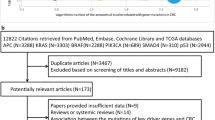Abstract
Colorectal cancer (CRC) is one of the most prevalent and life-threatening cancers. Rapid cell proliferation is the leading cause of cancer-related death in CRC. MicroRNAs (miRNAs) have been identified to play essential roles in the proliferation of CRC. Differential expression of let-7c-5p in CRC was assessed using a GEO dataset, and confirmed through RT-qPCR using CRC subject tissues. Let-7c-5p-overexpressing HCT8 cell line was constructed by transfecting let-7c-5p. Bioinformatics analysis identified that DUSP7 is the target gene of let-7c-5p. Further experimental assays, including Cell Counting Kit-8 (CCK8), EdU staining, cell colony, and Western Blot assays, confirmed the target genes and pathway of let-7c-5p. Receiver operator characteristic curve (ROC) analysis was performed to evaluate the diagnostic value of let-7c-5p for CRC. Finally, survival analysis was performed to determine the effect of DUSP7 and let-7c-5p on the prognosis of CRC patients. RT-qPCR analysis showed that the expression level of let-7c-5p was significantly increased in CRC subject tissues compared to the adjacent tissue. Overexpression of let-7c-5p promoted cell proliferation in HCT8 cell line. Furthermore, the MAPK-ERK pathway’s protein expression of p-ERK1/2 was downregulated, while the ratio of Bcl-2/Bax was increased by let-7c-5p transfection in HCT 8. ROC analysis demonstrated that the expressive level of let-7c-5p had higher diagnostic value for CRC. Survival curve analysis indicated that high expression of DUSP7 and low expression of let-7c-5p were associated with poor prognosis in CRC patients. The findings suggest that let-7c-5p exerts an antitumor function by inhibiting the DUSP7-mediated MAPK-ERK pathway. Both DUSP7 and let-7c-5p have the potential to serve as prognostic biomarkers in CRC patients.





Similar content being viewed by others
Data Availability
All data are available from the corresponding author on request.
Change history
21 February 2024
A Correction to this paper has been published: https://doi.org/10.1007/s10528-024-10736-2
References
Ashburner M, Ball CA, Blake JA et al (2000) Gene ontology: tool for the unification of biology. The Gene Ontology Consortium. Nat Genet 25(1):25–29
Bai H, Song M, Jiao R et al (2021) DUSP7 inhibits cervical cancer progression by inactivating the RAS pathway. J Cell Mol Med 25(19):9306–9318
Bech JM et al (2023) Proteomic profiling of colorectal adenomas identifies a predictive risk signature for development of metachronous advanced colorectal neoplasia. Gastroenterology 165(1):121–132
Chen H, Tong T, Lu SY et al (2023) Urea cycle activation triggered by host-microbiota maladaptation driving colorectal tumorigenesis. Cell Metab 35(4):651–666
Corrà F et al (2018) The Network of non-coding RNAs in cancer drug resistance. Front Oncol 8:327
Du M et al (2023) Integrated multi-omics approach to distinct molecular characterization and classification of early-onset colorectal cancer. Cell Rep Med 4(3):100974
Gene Ontology Consortium (2021) The Gene Ontology resource: enriching a GOld mine. Nucleic Acids Res 49(D1):D325–D334
Harrandah AM, Mora RA, Chan EKL (2018) Emerging microRNAs in cancer diagnosis, progression, and immune surveillance. Cancer Lett 438:126–132
Hill M, Tran N (2021) miRNA interplay: mechanisms and consequences in cancer. Dis Model Mech 14(4):dmm047662
Kanehisa M, Goto S (2000) KEGG: kyoto encyclopedia of genes and genomes. Nucleic Acids Res 28(1):27–30
Kanehisa M, Furumichi M, Sato Y et al (2023) KEGG for taxonomy-based analysis of pathways and genomes. Nucleic Acids Res 51(D1):D587–D592
Latest global cancer data: cancer burden rises to 19.3 million new cases and 10.0 million cancer deaths in 2020 questions and answers (Q&A) (2020) https://gco.iarc.fr/
Wang C, Xue H, Zhao R et al (2022) RGS16 regulated by let-7c-5p promotes glioma progression by activating PI3K-AKT pathway. Front Med
Winawer SJ, Zauber AG, Ho MN et al (1993) Prevention of colorectal cancer by colonoscopic polypectomy. The National Polyp Study Workgroup. N Engl J Med 329(27):1977–1981
Wu Y, Zhang Y, Zheng X et al (2020) Circular RNA circCORO1C promotes laryngeal squamous cell carcinoma progression by modulating the let-7c-5p/PBX3 axis. Mol Cancer 19(1):1–18
Zheng Y, Luo M, Lü M et al (2020) Let-7c-5p inhibits cell proliferation and migration and promotes apoptosis via the CTHRC1/AKT/ERK pathway in esophageal squamous cell carcinoma. Onco Targets Ther 13:11193–11209
Acknowledgements
The authors thank the financial support of Hebei Provincial of Human Resources and Social Security as well as Chengde Medical University.
Funding
The study was supported by Hebei Provincial of Human Resources and Social Security (CY201701, CY201702).
Author information
Authors and Affiliations
Contributions
FJJ, HZP and HPY designed the study and wrote the manuscript. LSJ and ZLM carried out data analysis, HWJ prepared pathological slides. All authors have read and approved the manuscript.
Corresponding authors
Ethics declarations
Competing interests
The authors declared no potential conflicts of interest concerning the research, authorship, and/or publication of this article.
Ethical Approval
The studies involving human participants were reviewed and approved by the Ethics Committee of Chengde Medical University.
Consent to Participate
All patients signed an informed consent form.
Consent for Publication
Consent for publication was obtained from the participants.
Additional information
Publisher's Note
Springer Nature remains neutral with regard to jurisdictional claims in published maps and institutional affiliations.
The original online version of this article was revised: The affiliation 'Basic College of Chengde Medical University, Chengde, Hebei, China' has been removed.
Rights and permissions
Springer Nature or its licensor (e.g. a society or other partner) holds exclusive rights to this article under a publishing agreement with the author(s) or other rightsholder(s); author self-archiving of the accepted manuscript version of this article is solely governed by the terms of such publishing agreement and applicable law.
About this article
Cite this article
Fu, J., Zhou, L., Li, S. et al. Let-7c-5p Down Regulates the Proliferation of Colorectal Cancer Through the MAPK-ERK-Signaling Pathway. Biochem Genet (2023). https://doi.org/10.1007/s10528-023-10581-9
Received:
Accepted:
Published:
DOI: https://doi.org/10.1007/s10528-023-10581-9




